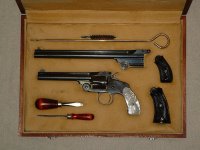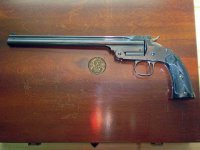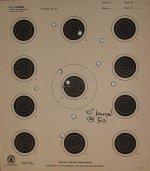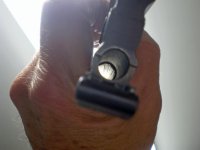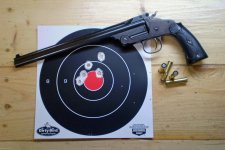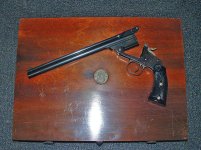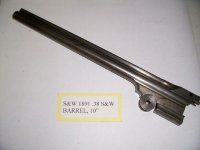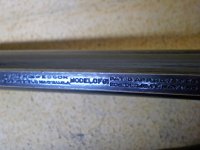I have been struggling with a 38 Single Shot barrel I had acquired through a source that purchased a large lot of factory leftover stock years ago. These barrels had never been issued and were in the white without serial numbers, but had the proper barrel rib stamping for a Model of ‘91. I purchased a 10” barrel in, what was advertised as 38 S&W. This source had all calibers originally available at the time, but I knew that the 38 barrel was the most uncommon caliber out there, so I bought one.
I had a nice Model of 1891 factory target revolver, 38 S&W, that I had received from a SWCA member and thought that barrel would complement the revolver. After receiving the barrel, I blued it and, through the assistance of a few more members here, I acquired and/or made parts to install an extractor, sights, and put together the Single Shot. On my first trip to the range, plus several more, I could not come up with a load that would hit paper at 25 yards and very inaccurate at 50 feet (photo 1). Trying several different types of bullets, powders, and crimp styles, I saw no improvements. As I was cleaning the barrel recently, I noticed the chamber seemed quite deep, so measuring the chamber I found it to be much longer than a 38 S&W round. Now thinking it might have been bored out for 357 brass, I loaded up some 357 Mag cases with .360 bullets and they would chamber easily and still seemed short, plus there was no improvement at the range. Was about to give up on the SS barrel, but a very learned member here suggested that I check the chamber measurement and compare it to a 38/44 Target case. As it turns out, the chamber was exactly the same length as an old 38/44 Target round.
I acquired 50 rounds of 357 Remington Max and cut it down to just under 1.5”. Used a 158 grain gas check SWC. Interesting that those bullets from my mold are .361”, just what I needed. Added 3.2 grains of Unique and filled the case with Puflon. Velocity averaged 661 fps and accuracy improved dramatically at 15 yards. Now I am onto something here and look forward to loading more ammo to shoot at longer ranges with different powders and bullets to further improve accuracy.
Pictures are of the assembled set that I had shared when I first put together a case from an old silverware wood box (photos 2 & 3). The chamber shows no sign of ever being bored out (photo 4), so am wondering if it was something the factory may have played with during the production time of the 1st Model Single Shot? All I can say is the accuracy is much improved (photo 5).
Bottom line is that I might have the only 38/44 Target barrel out there, but tough to get a letter on a unnumbered barrel. Just another fun adventure with a S&W.
I had a nice Model of 1891 factory target revolver, 38 S&W, that I had received from a SWCA member and thought that barrel would complement the revolver. After receiving the barrel, I blued it and, through the assistance of a few more members here, I acquired and/or made parts to install an extractor, sights, and put together the Single Shot. On my first trip to the range, plus several more, I could not come up with a load that would hit paper at 25 yards and very inaccurate at 50 feet (photo 1). Trying several different types of bullets, powders, and crimp styles, I saw no improvements. As I was cleaning the barrel recently, I noticed the chamber seemed quite deep, so measuring the chamber I found it to be much longer than a 38 S&W round. Now thinking it might have been bored out for 357 brass, I loaded up some 357 Mag cases with .360 bullets and they would chamber easily and still seemed short, plus there was no improvement at the range. Was about to give up on the SS barrel, but a very learned member here suggested that I check the chamber measurement and compare it to a 38/44 Target case. As it turns out, the chamber was exactly the same length as an old 38/44 Target round.
I acquired 50 rounds of 357 Remington Max and cut it down to just under 1.5”. Used a 158 grain gas check SWC. Interesting that those bullets from my mold are .361”, just what I needed. Added 3.2 grains of Unique and filled the case with Puflon. Velocity averaged 661 fps and accuracy improved dramatically at 15 yards. Now I am onto something here and look forward to loading more ammo to shoot at longer ranges with different powders and bullets to further improve accuracy.
Pictures are of the assembled set that I had shared when I first put together a case from an old silverware wood box (photos 2 & 3). The chamber shows no sign of ever being bored out (photo 4), so am wondering if it was something the factory may have played with during the production time of the 1st Model Single Shot? All I can say is the accuracy is much improved (photo 5).
Bottom line is that I might have the only 38/44 Target barrel out there, but tough to get a letter on a unnumbered barrel. Just another fun adventure with a S&W.

